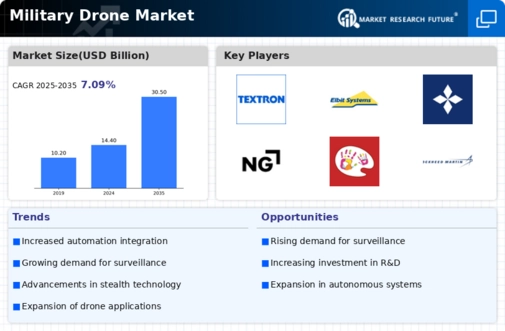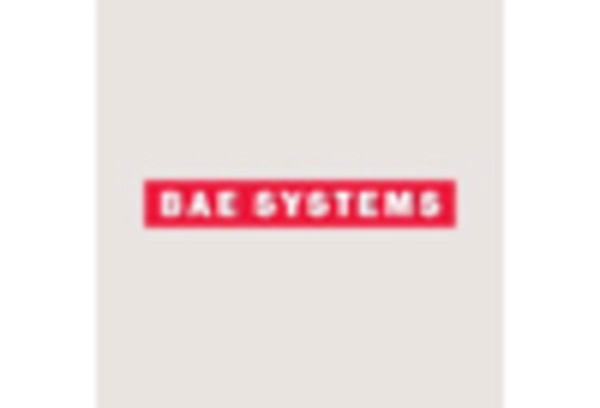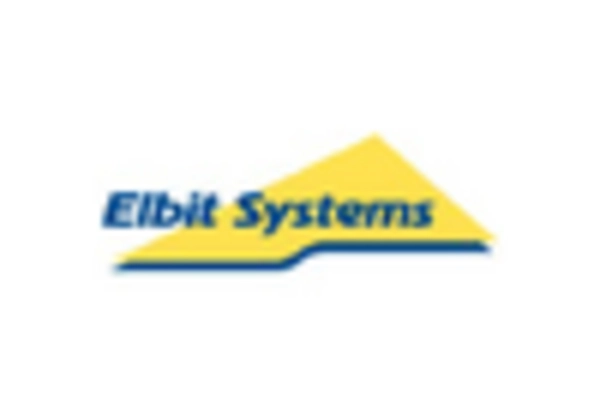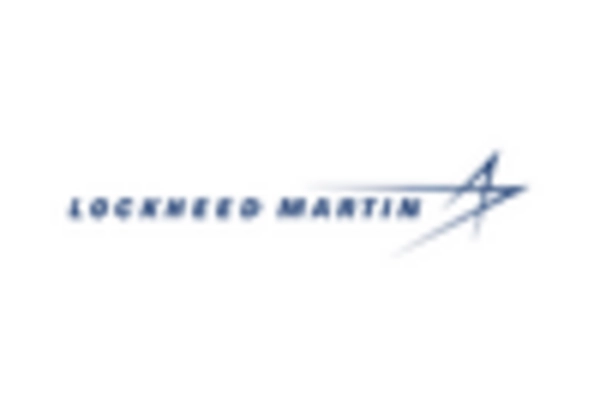Surveillance
Combat
Logistics
Reconnaissance
Training
Fixed-Wing Drones
Rotary-Wing Drones
Hybrid Drones
Miniature Drones
Defense
Homeland Security
Research and Development
Less than 25 kg
25 kg to 100 kg
More than 100 kg
North America
Europe
South America
Asia Pacific
Middle East and Africa
North America Outlook (USD Billion, 2019-2035)
North America Military Drone Market by Application Type
Surveillance
Combat
Logistics
Reconnaissance
Training
North America Military Drone Market by Type
Fixed-Wing Drones
Rotary-Wing Drones
Hybrid Drones
Miniature Drones
North America Military Drone Market by End Use Type
Defense
Homeland Security
Research and Development
North America Military Drone Market by Payload Capacity Type
Less than 25 kg
25 kg to 100 kg
More than 100 kg
North America Military Drone Market by Regional Type
US
Canada
US Outlook (USD Billion, 2019-2035)
US Military Drone Market by Application Type
Surveillance
Combat
Logistics
Reconnaissance
Training
US Military Drone Market by Type
Fixed-Wing Drones
Rotary-Wing Drones
Hybrid Drones
Miniature Drones
US Military Drone Market by End Use Type
Defense
Homeland Security
Research and Development
US Military Drone Market by Payload Capacity Type
Less than 25 kg
25 kg to 100 kg
More than 100 kg
CANADA Outlook (USD Billion, 2019-2035)
CANADA Military Drone Market by Application Type
Surveillance
Combat
Logistics
Reconnaissance
Training
CANADA Military Drone Market by Type
Fixed-Wing Drones
Rotary-Wing Drones
Hybrid Drones
Miniature Drones
CANADA Military Drone Market by End Use Type
Defense
Homeland Security
Research and Development
CANADA Military Drone Market by Payload Capacity Type
Less than 25 kg
25 kg to 100 kg
More than 100 kg
Europe Outlook (USD Billion, 2019-2035)
Europe Military Drone Market by Application Type
Surveillance
Combat
Logistics
Reconnaissance
Training
Europe Military Drone Market by Type
Fixed-Wing Drones
Rotary-Wing Drones
Hybrid Drones
Miniature Drones
Europe Military Drone Market by End Use Type
Defense
Homeland Security
Research and Development
Europe Military Drone Market by Payload Capacity Type
Less than 25 kg
25 kg to 100 kg
More than 100 kg
Europe Military Drone Market by Regional Type
Germany
UK
France
Russia
Italy
Spain
Rest of Europe
GERMANY Outlook (USD Billion, 2019-2035)
GERMANY Military Drone Market by Application Type
Surveillance
Combat
Logistics
Reconnaissance
Training
GERMANY Military Drone Market by Type
Fixed-Wing Drones
Rotary-Wing Drones
Hybrid Drones
Miniature Drones
GERMANY Military Drone Market by End Use Type
Defense
Homeland Security
Research and Development
GERMANY Military Drone Market by Payload Capacity Type
Less than 25 kg
25 kg to 100 kg
More than 100 kg
UK Outlook (USD Billion, 2019-2035)
UK Military Drone Market by Application Type
Surveillance
Combat
Logistics
Reconnaissance
Training
UK Military Drone Market by Type
Fixed-Wing Drones
Rotary-Wing Drones
Hybrid Drones
Miniature Drones
UK Military Drone Market by End Use Type
Defense
Homeland Security
Research and Development
UK Military Drone Market by Payload Capacity Type
Less than 25 kg
25 kg to 100 kg
More than 100 kg
FRANCE Outlook (USD Billion, 2019-2035)
FRANCE Military Drone Market by Application Type
Surveillance
Combat
Logistics
Reconnaissance
Training
FRANCE Military Drone Market by Type
Fixed-Wing Drones
Rotary-Wing Drones
Hybrid Drones
Miniature Drones
FRANCE Military Drone Market by End Use Type
Defense
Homeland Security
Research and Development
FRANCE Military Drone Market by Payload Capacity Type
Less than 25 kg
25 kg to 100 kg
More than 100 kg
RUSSIA Outlook (USD Billion, 2019-2035)
RUSSIA Military Drone Market by Application Type
Surveillance
Combat
Logistics
Reconnaissance
Training
RUSSIA Military Drone Market by Type
Fixed-Wing Drones
Rotary-Wing Drones
Hybrid Drones
Miniature Drones
RUSSIA Military Drone Market by End Use Type
Defense
Homeland Security
Research and Development
RUSSIA Military Drone Market by Payload Capacity Type
Less than 25 kg
25 kg to 100 kg
More than 100 kg
ITALY Outlook (USD Billion, 2019-2035)
ITALY Military Drone Market by Application Type
Surveillance
Combat
Logistics
Reconnaissance
Training
ITALY Military Drone Market by Type
Fixed-Wing Drones
Rotary-Wing Drones
Hybrid Drones
Miniature Drones
ITALY Military Drone Market by End Use Type
Defense
Homeland Security
Research and Development
ITALY Military Drone Market by Payload Capacity Type
Less than 25 kg
25 kg to 100 kg
More than 100 kg
SPAIN Outlook (USD Billion, 2019-2035)
SPAIN Military Drone Market by Application Type
Surveillance
Combat
Logistics
Reconnaissance
Training
SPAIN Military Drone Market by Type
Fixed-Wing Drones
Rotary-Wing Drones
Hybrid Drones
Miniature Drones
SPAIN Military Drone Market by End Use Type
Defense
Homeland Security
Research and Development
SPAIN Military Drone Market by Payload Capacity Type
Less than 25 kg
25 kg to 100 kg
More than 100 kg
REST OF EUROPE Outlook (USD Billion, 2019-2035)
REST OF EUROPE Military Drone Market by Application Type
Surveillance
Combat
Logistics
Reconnaissance
Training
REST OF EUROPE Military Drone Market by Type
Fixed-Wing Drones
Rotary-Wing Drones
Hybrid Drones
Miniature Drones
REST OF EUROPE Military Drone Market by End Use Type
Defense
Homeland Security
Research and Development
REST OF EUROPE Military Drone Market by Payload Capacity Type
Less than 25 kg
25 kg to 100 kg
More than 100 kg
APAC Outlook (USD Billion, 2019-2035)
APAC Military Drone Market by Application Type
Surveillance
Combat
Logistics
Reconnaissance
Training
APAC Military Drone Market by Type
Fixed-Wing Drones
Rotary-Wing Drones
Hybrid Drones
Miniature Drones
APAC Military Drone Market by End Use Type
Defense
Homeland Security
Research and Development
APAC Military Drone Market by Payload Capacity Type
Less than 25 kg
25 kg to 100 kg
More than 100 kg
APAC Military Drone Market by Regional Type
China
India
Japan
South Korea
Malaysia
Thailand
Indonesia
Rest of APAC
CHINA Outlook (USD Billion, 2019-2035)
CHINA Military Drone Market by Application Type
Surveillance
Combat
Logistics
Reconnaissance
Training
CHINA Military Drone Market by Type
Fixed-Wing Drones
Rotary-Wing Drones
Hybrid Drones
Miniature Drones
CHINA Military Drone Market by End Use Type
Defense
Homeland Security
Research and Development
CHINA Military Drone Market by Payload Capacity Type
Less than 25 kg
25 kg to 100 kg
More than 100 kg
INDIA Outlook (USD Billion, 2019-2035)
INDIA Military Drone Market by Application Type
Surveillance
Combat
Logistics
Reconnaissance
Training
INDIA Military Drone Market by Type
Fixed-Wing Drones
Rotary-Wing Drones
Hybrid Drones
Miniature Drones
INDIA Military Drone Market by End Use Type
Defense
Homeland Security
Research and Development
INDIA Military Drone Market by Payload Capacity Type
Less than 25 kg
25 kg to 100 kg
More than 100 kg
JAPAN Outlook (USD Billion, 2019-2035)
JAPAN Military Drone Market by Application Type
Surveillance
Combat
Logistics
Reconnaissance
Training
JAPAN Military Drone Market by Type
Fixed-Wing Drones
Rotary-Wing Drones
Hybrid Drones
Miniature Drones
JAPAN Military Drone Market by End Use Type
Defense
Homeland Security
Research and Development
JAPAN Military Drone Market by Payload Capacity Type
Less than 25 kg
25 kg to 100 kg
More than 100 kg
SOUTH KOREA Outlook (USD Billion, 2019-2035)
SOUTH KOREA Military Drone Market by Application Type
Surveillance
Combat
Logistics
Reconnaissance
Training
SOUTH KOREA Military Drone Market by Type
Fixed-Wing Drones
Rotary-Wing Drones
Hybrid Drones
Miniature Drones
SOUTH KOREA Military Drone Market by End Use Type
Defense
Homeland Security
Research and Development
SOUTH KOREA Military Drone Market by Payload Capacity Type
Less than 25 kg
25 kg to 100 kg
More than 100 kg
MALAYSIA Outlook (USD Billion, 2019-2035)
MALAYSIA Military Drone Market by Application Type
Surveillance
Combat
Logistics
Reconnaissance
Training
MALAYSIA Military Drone Market by Type
Fixed-Wing Drones
Rotary-Wing Drones
Hybrid Drones
Miniature Drones
MALAYSIA Military Drone Market by End Use Type
Defense
Homeland Security
Research and Development
MALAYSIA Military Drone Market by Payload Capacity Type
Less than 25 kg
25 kg to 100 kg
More than 100 kg
THAILAND Outlook (USD Billion, 2019-2035)
THAILAND Military Drone Market by Application Type
Surveillance
Combat
Logistics
Reconnaissance
Training
THAILAND Military Drone Market by Type
Fixed-Wing Drones
Rotary-Wing Drones
Hybrid Drones
Miniature Drones
THAILAND Military Drone Market by End Use Type
Defense
Homeland Security
Research and Development
THAILAND Military Drone Market by Payload Capacity Type
Less than 25 kg
25 kg to 100 kg
More than 100 kg
INDONESIA Outlook (USD Billion, 2019-2035)
INDONESIA Military Drone Market by Application Type
Surveillance
Combat
Logistics
Reconnaissance
Training
INDONESIA Military Drone Market by Type
Fixed-Wing Drones
Rotary-Wing Drones
Hybrid Drones
Miniature Drones
INDONESIA Military Drone Market by End Use Type
Defense
Homeland Security
Research and Development
INDONESIA Military Drone Market by Payload Capacity Type
Less than 25 kg
25 kg to 100 kg
More than 100 kg
REST OF APAC Outlook (USD Billion, 2019-2035)
REST OF APAC Military Drone Market by Application Type
Surveillance
Combat
Logistics
Reconnaissance
Training
REST OF APAC Military Drone Market by Type
Fixed-Wing Drones
Rotary-Wing Drones
Hybrid Drones
Miniature Drones
REST OF APAC Military Drone Market by End Use Type
Defense
Homeland Security
Research and Development
REST OF APAC Military Drone Market by Payload Capacity Type
Less than 25 kg
25 kg to 100 kg
More than 100 kg
South America Outlook (USD Billion, 2019-2035)
South America Military Drone Market by Application Type
Surveillance
Combat
Logistics
Reconnaissance
Training
South America Military Drone Market by Type
Fixed-Wing Drones
Rotary-Wing Drones
Hybrid Drones
Miniature Drones
South America Military Drone Market by End Use Type
Defense
Homeland Security
Research and Development
South America Military Drone Market by Payload Capacity Type
Less than 25 kg
25 kg to 100 kg
More than 100 kg
South America Military Drone Market by Regional Type
Brazil
Mexico
Argentina
Rest of South America
BRAZIL Outlook (USD Billion, 2019-2035)
BRAZIL Military Drone Market by Application Type
Surveillance
Combat
Logistics
Reconnaissance
Training
BRAZIL Military Drone Market by Type
Fixed-Wing Drones
Rotary-Wing Drones
Hybrid Drones
Miniature Drones
BRAZIL Military Drone Market by End Use Type
Defense
Homeland Security
Research and Development
BRAZIL Military Drone Market by Payload Capacity Type
Less than 25 kg
25 kg to 100 kg
More than 100 kg
MEXICO Outlook (USD Billion, 2019-2035)
MEXICO Military Drone Market by Application Type
Surveillance
Combat
Logistics
Reconnaissance
Training
MEXICO Military Drone Market by Type
Fixed-Wing Drones
Rotary-Wing Drones
Hybrid Drones
Miniature Drones
MEXICO Military Drone Market by End Use Type
Defense
Homeland Security
Research and Development
MEXICO Military Drone Market by Payload Capacity Type
Less than 25 kg
25 kg to 100 kg
More than 100 kg
ARGENTINA Outlook (USD Billion, 2019-2035)
ARGENTINA Military Drone Market by Application Type
Surveillance
Combat
Logistics
Reconnaissance
Training
ARGENTINA Military Drone Market by Type
Fixed-Wing Drones
Rotary-Wing Drones
Hybrid Drones
Miniature Drones
ARGENTINA Military Drone Market by End Use Type
Defense
Homeland Security
Research and Development
ARGENTINA Military Drone Market by Payload Capacity Type
Less than 25 kg
25 kg to 100 kg
More than 100 kg
REST OF SOUTH AMERICA Outlook (USD Billion, 2019-2035)
REST OF SOUTH AMERICA Military Drone Market by Application Type
Surveillance
Combat
Logistics
Reconnaissance
Training
REST OF SOUTH AMERICA Military Drone Market by Type
Fixed-Wing Drones
Rotary-Wing Drones
Hybrid Drones
Miniature Drones
REST OF SOUTH AMERICA Military Drone Market by End Use Type
Defense
Homeland Security
Research and Development
REST OF SOUTH AMERICA Military Drone Market by Payload Capacity Type
Less than 25 kg
25 kg to 100 kg
More than 100 kg
MEA Outlook (USD Billion, 2019-2035)
MEA Military Drone Market by Application Type
Surveillance
Combat
Logistics
Reconnaissance
Training
MEA Military Drone Market by Type
Fixed-Wing Drones
Rotary-Wing Drones
Hybrid Drones
Miniature Drones
MEA Military Drone Market by End Use Type
Defense
Homeland Security
Research and Development
MEA Military Drone Market by Payload Capacity Type
Less than 25 kg
25 kg to 100 kg
More than 100 kg
MEA Military Drone Market by Regional Type
GCC Countries
South Africa
Rest of MEA
GCC COUNTRIES Outlook (USD Billion, 2019-2035)
GCC COUNTRIES Military Drone Market by Application Type
Surveillance
Combat
Logistics
Reconnaissance
Training
GCC COUNTRIES Military Drone Market by Type
Fixed-Wing Drones
Rotary-Wing Drones
Hybrid Drones
Miniature Drones
GCC COUNTRIES Military Drone Market by End Use Type
Defense
Homeland Security
Research and Development
GCC COUNTRIES Military Drone Market by Payload Capacity Type
Less than 25 kg
25 kg to 100 kg
More than 100 kg
SOUTH AFRICA Outlook (USD Billion, 2019-2035)
SOUTH AFRICA Military Drone Market by Application Type
Surveillance
Combat
Logistics
Reconnaissance
Training
SOUTH AFRICA Military Drone Market by Type
Fixed-Wing Drones
Rotary-Wing Drones
Hybrid Drones
Miniature Drones
SOUTH AFRICA Military Drone Market by End Use Type
Defense
Homeland Security
Research and Development
SOUTH AFRICA Military Drone Market by Payload Capacity Type
Less than 25 kg
25 kg to 100 kg
More than 100 kg
REST OF MEA Outlook (USD Billion, 2019-2035)
REST OF MEA Military Drone Market by Application Type
Surveillance
Combat
Logistics
Reconnaissance
Training
REST OF MEA Military Drone Market by Type
Fixed-Wing Drones
Rotary-Wing Drones
Hybrid Drones
Miniature Drones
REST OF MEA Military Drone Market by End Use Type
Defense
Homeland Security
Research and Development
REST OF MEA Military Drone Market by Payload Capacity Type
Less than 25 kg
25 kg to 100 kg
More than 100 kg

















Leave a Comment